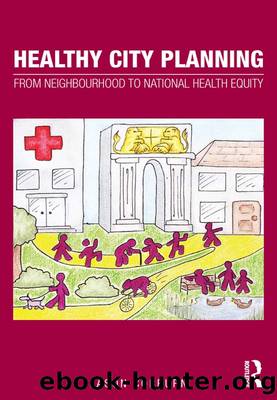Healthy City Planning by Corburn Jason;

Author:Corburn, Jason;
Language: eng
Format: epub
ISBN: 1170354
Publisher: Taylor & Francis Group
The Brazilian Fight against AIDS: Relational Policy-Making for Health Equity
Brazilian health reform in the 1980s took place in the shadow of a growing national HIV/ AIDS epidemic.4 The first national AIDS programme was established in the country in 1986, but received little funding (Levi and Vitória, 2002). However the Brazilian government's response to AIDS in the 1980s was largely driven by mobilized civil society groups in cities (BMH, 2001; Parker, 2003, 2009). A linked movement for civil rights, urban policy and health reform â referred to as the Movimento Sanitário â emerged in São Paulo and grew to include Rio (Parker, 2003). One of the movement's first demands was to establish municipal AIDS programmes rather than leaving the responsibility with the national health ministry. Decentralization of HIV/AIDS prevention meant that municipalities had to find creative and cost effective ways to prevent the spread of the disease, since they would be burdened with the responsibility of care.
The growing movement also set out to challenge the federal government about patent rights for emerging antiretroviral (ARV) drug therapies that were under the control of American and European pharmaceutical corporations. The activists demanded that the Brazilian government invoke a clause in international trade and patent law that allows developing countries to break patents for emergency health reasons without sanctions. Brazil agreed and sought what are called compulsory licences to produce generic versions of patented drugs for domestic use.5 No other country in the world had invoked this clause. By 1996, Brazil had passed a law granting all Brazilians' free access to antiretroviral drugs through the National Health System and cheap ARVs were the only way to make this a reality (Nunn et al., 2009). Brazil issued the compulsory licenses, stimulating a large domestic pharmaceutical industry of ARVs producers, among other drugs ++(Parker, 2003).6 By 2011, Brazil was producing at least eight different ARVs that are part of today's AIDS drug cocktail (Paim et al., 2011). While pharmaceutical companies and the US challenged Brazil's decision, social movements pressured the government to persist and continue with the programme (Galvao, 2005). Today, Brazil's drug industry is the eighth largest in the world, and continues to be supported by the Ministry of Health's policy of reducing the importation of drugs and the promotion of generic drugs (Paim et al., 2011).
Another feature of the AIDS programme was to de-stigmatize the disease, testing and prevention. This was particularly challenging in a country with a strong Catholic tradition (Parker, 2003). However, activists took on the rhetoric of the church early in their campaigns and worked with municipal governments to develop campaigns focused on condom distribution and use and sex education. In addition, activists worked to pass legislation recognizing and protecting homosexual and transsexual rights and legalizing commercial sex work. Policies and programmes followed that distributed clean needles for intravenous drug users, targeted prison health and made blood screening mandatory.
The Brazilian AIDS programme, for which the country won the âHuman Rights and Culture of Peaceâ prize from the United Nations Educational, Scientific and Cultural Organization (UNESCO) in 2001, is recognized around the world as a monumental success.
Download
This site does not store any files on its server. We only index and link to content provided by other sites. Please contact the content providers to delete copyright contents if any and email us, we'll remove relevant links or contents immediately.
Application of a Novel Technique for Clinical Evaluation of Nitric Oxide-Induced Free Radical Reactions in ICU Patients by Unknown(696)
Rosenâs Emergency Medicine Concepts and Clinical Practice by Ron Walls; Robert Hockberger; Marianne Gausche-Hill; Timothy B. Erickson; Susan R. Wilcox(574)
Oxidative damage to surfactant protein D in pulmonary diseases by Vitality Starosta1 & Matthias Griese1†(410)
Social Science Perspectives on Global Public Health by Vincent La Placa & Julia Morgan(375)
Constructing Canine Consent; Conceptualising and Adopting a Consent-focused Relationship with Dogs by ERIN JONES(330)
Organic Chemistry: An Acid - Base Approach by MICHAEL SMITH(304)
ADVANCED EMERGENCY CARE AND TRANSPORTATION OF THE SICK AND INJURED by Unknown(272)
Saunders Nursing Drug Handbook 2024 - E-Book by Unknown(263)
Davis's Comprehensive Manual of Laboratory and Diagnostic Tests with Nursing Implications by Unknown(250)
Socio-Life Science and the COVID-19 Outbreak : Public Health and Public Policy by Makoto Yano; Fumihiko Matsuda; Anavaj Sakuntabhai; Shigeru Hirota(247)
Diagnostic and Statistical Manual of Mental Disorders, Fifth Edition, Text Revision (DSM-5-TR(tm)) by Unknown(246)
Human Microanatomy; Cell Tissue and Organ Histology with Celebrity Medical Histories by Stephen A. Stricker(245)
Berne and Levy Physiology E-Book by Unknown(237)
Replacing the Dead by Mie Nakachi;(232)
Handbook of Skin Disease Management by Jiyad Zainab;Flohr Carsten; & Carsten Flohr(229)
Access to Medicines and Vaccines in the South : Coherence of Rules and Policies Applied by the European Union Commission by Stephen Kingah(226)
Deep Learning and Medical Applications by Unknown(222)
The Pocket Guide to Sensorimotor Psychotherapy in Context (Norton Series on Interpersonal Neurobiology) by Pat Ogden(218)
Advances and Technical Standards in Neurosurgery by Unknown(215)
